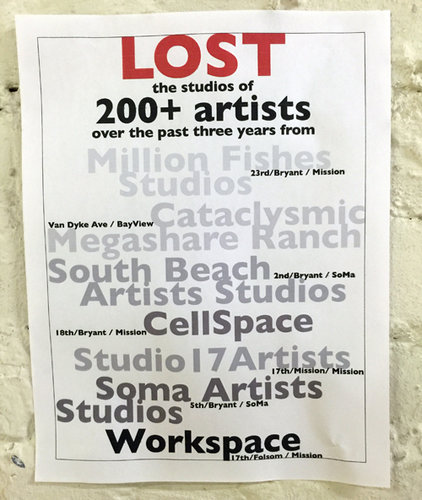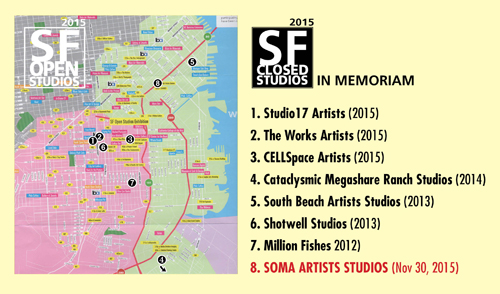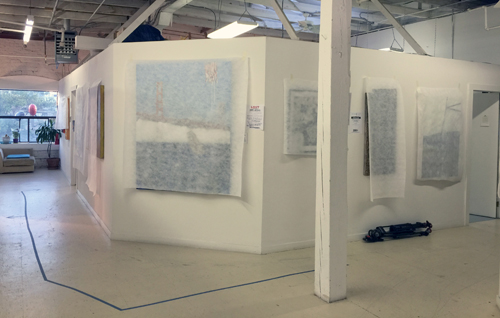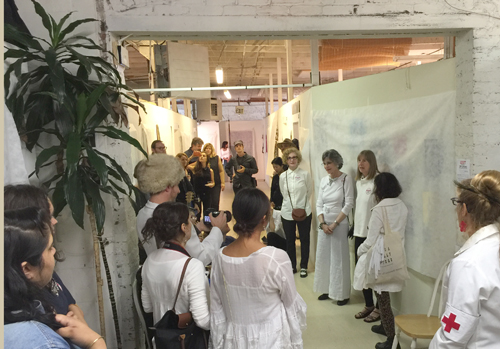by guest blogger Flora Davis
In late November of 2014, the countdown toward eviction at Soma Artists Studios began. After twenty-six years, 43 artists were being priced out of their San Francisco studio building.

The economic landscape of San Francisco was changing. It has been occurring in large cities across the United States and Europe. People were moving back to cities to live or work in the booming tech sector. As a result, real estate prices surged. Speculators, developers, and outside money kicked off a building boom, then a frenzy. Evictions gradually soared as older neighborhoods gentrified.
Right before my eyes, the city I loved was rapidly changing, and not in good ways. To be sure, I am not against change. The excitement change brings is an integral part of creativity. Instead, out-of-control greed was prevailing over human values. And, neither the Mayor, nor the supervisors, nor the Planning Department, seemed to understand the ramifications of this unfolding crisis, a crisis that has awarded the city of Saint Francis the distinction of being number one in the nation in income inequality.
I was losing my studio, but I saw I could be losing a lot more.
I saw a need to counter, in any way I could, the city’s soul being sucked away. This is how I became an accidental activist for the arts. I did not have much prior experience as an activist, but knew what was essential to create change was love, vision, and grit. And, from past experience, that even a small dedicated group of individuals could make a difference.

My focus was a love of the arts, which led to a new circle of like-minded individuals. By March of 2015, we formed the Cultural Space Coalition as a way to help connect groups and individuals who are working to reverse the trend of disappearing cultural spaces.
Getting the attention of the city government agencies was a daunting task. Previous communications with my district’s city supervisor had gone nowhere. A break happened serendipitously by way of an introduction to the director of a tenants right’s group. This man had connections. In short time, another meeting at this same supervisor’s office was called, initiating conversations concerning the displacement of artists. It soon included the supervisors and their aides for the SoMa District and Mission District’s, where cultural spaces were at most risk. By the end of summer we were unable to save the artists at CELLSpace and Studio 17, and close to 100 artists were lost. But boy, we put up a hell of a fight!
Another turn-around occurred the same day CELLSpace was celebrating its existence and eminent closing. The group made the dramatic decision to fight their eviction. (Thanks to our efforts, this major block-sized development is now on hold, but not dead.) At the event, a nascent group, eventually calling itself Cultural Action Network (CAN), emerged.

The Whiteout of Arts and Culture Exhibition.
I eventually found myself intertwined in these two groups. But more important, these two organizations, and the committed individuals involved, started gaining attention and results. As activist artists we planned events that garnered media attention, such as “Closed Studios” and “Reversing the Whiteout of Arts and Culture.” Through our work, artists also now have place at the table in discussions about the crisis. We helped find artists to participate in a survey on displacement by the San Francisco Art Commission. We began to partner with housing activists, getting demands for artist spaces alongside affordable housing, connecting hundreds of people and organizations.
Our meetings at City Hall now involve a wide and diverse group of concerned activists, arts groups, and city officials. The list of what needs to be addressed has grown to include: increased fines and enforcement of PDR (the zoning designation that includes artist spaces); protection of existing PDR with 1-1 replacement; an artist registry; a cultural space registry; construction of affordable artist live/work housing; identifying buildings for purchase by the City or a non-profit; and getting developer agreements to include affordable artist space.

But while we try to find solutions, the citywide crisis mounts. WeWork, a startup that builds physical and virtual communities, displaced two anti-eviction non-profits from a PDR space. The WeWorks’ memes of “Trying to Change the World,” “Don’t Give Up on Your Dreams!” and “Do What You Love” felt hollow and removed from the realities on the streets. But more so, the tech invasion was co-opting the language of the very people they were displacing: those funky creative types.
On the last day of November 2015, the unfortunate day arrived; Forty-three artists were evicted from Soma Artists Studios. Only thirteen found new studios; many are temporary. I am one of the lucky ones, in a space for at least a year.
The Soma Artist’s studio building is vacant. CAN is suspicious of this property owner’s intentions. We informed him that we will be watching.
 Flora Davis’ studio is located in San Francisco, California. Metal is her medium. She manipulates the surface, creating patinas that are organic, random and spontaneous. The metals are either adhered to panels or bent into wall sculptures. Her work is in both private and corporate collections.
Flora Davis’ studio is located in San Francisco, California. Metal is her medium. She manipulates the surface, creating patinas that are organic, random and spontaneous. The metals are either adhered to panels or bent into wall sculptures. Her work is in both private and corporate collections.


Thank you for this last update.Here in the UK we have many similar situations. I live in Milton Keynes Buckinghamshire. We are the number one UK city for business and at present there barely any established art spaces for a large,and growing community of artists Business is king and profits are the focus…
We will continue to create!
Steve Urwin
Steve, I am hearing from artists all over that they experience the same thing. San Francisco is most likely the most expensive city in the US – rents are through the roof, and clearly the arts are not a priority.
What I find so sad is that when areas are distressed, in need of recovery and renewal, artists are the “first responders” who move in to turn it around. They brave the wreckage to bring about a Renaissance. This attracts notice, visitors, tourism – and then the restaurants and night spots move in to serve the crowds that come. Then, the developers see an opportunity, they snap up real estate, and throw out the artists who were the source of the attraction, opting for high rents from people who want to live and work in a revitalized area.
You’ve just described the Montrose area in Houston.
Thanks for sharing this.
People over profits (which doesn’t just mean the artists in this case but the communities that are enriched by our work as well)…
Keep up the good fight!
Thank you for bringing even more awareness to this. I just hope something can be done to stop it.
Yes, something can be done. But it is work and a challenge to go against the stream where Profits are valued over everything else. We are doing this in San Francisco, and through our efforts are seeing small successes. We are not in the same place since January 2015. An accumulative process is happening with each of our small successes. And, the more we join forces wth other like-minded groups and individuals, change can and will happen! This all takes Love, vision and grit!
Thanks for summing up the history of San Francisco Arts Activists. We welcome all supporters to help stem the tide of cultural genocide. We need creative people to help us find solutions to all our problems. We need to educate and empower individuals to learn how to work within the government to change things they don’t like.